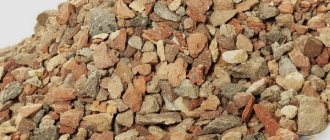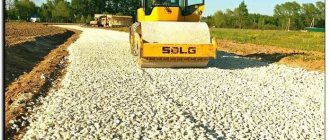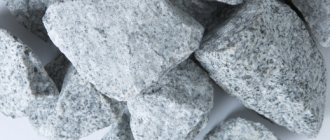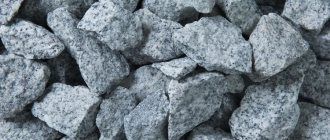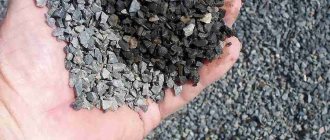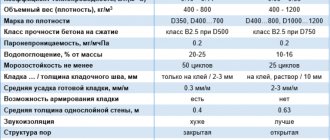- June 25, 2020
Modern construction involves the use of high-quality materials, including crushed stone. Indicators of strength and reliability play a major role in the durability of the structure and concrete products. Time dictates modern requirements for the quality of constructed facilities, highways, and products using concrete. Construction crushed stone is a filler combined with cement, sand and water. This mixture is called concrete; due to its strength, it has a wide range of applications. Therefore, choosing crushed stone for construction with the necessary parameters will be an important task before starting work.
More about mining
As already mentioned, crushed stone is a by-product of the extraction of non-metallic minerals, mainly hard rocks: granite, rock mass, limestone. When removing the main layers and excavating blocks of different volumes from the massif, fragments break off from the main rock, which are collected and sorted into fractions through sieves with different mesh sizes. If necessary, stones are crushed to the required size.
In addition, crushed stone is obtained as a result of processing materials in the metallurgical industry (slag crushed stone) or crushing used reinforced concrete products and bricks, building blocks.
The crushed stone fraction means the size of the stones of the predominant volume of the batch, for 20...40 these are convex-shaped fragments with a width or length from 20 to 40 millimeters inclusive.
Crushed stone fractions
Crushed gravel is divided into fractions. Each of them is used for some primary purpose.
There is the following division:
- up to 5 mm. Gravel screening is usually used for ice prevention or landscaping work, as it is very fine;
- up to 10 mm. The main use is concrete production, landscaping, foundation construction;
- up to 20 mm. Is the most popular. The main use is the production of cement, cement products, foundation construction;
- up to 40 mm. The main use, as in other cases, is foundation work, the production of concrete and concrete products. Additionally required for drainage work;
- up to 70 or up to 90 mm. Necessary for both previous purposes and for decorative purposes. Widely applicable in road construction;
- up to 150 mm. This faction has its own name - BUT. A very rare species, used for decorative purposes, as well as as the main material for finishing ponds, pools, drains or river banks.
Varieties
The strength and density of crushed stone of fraction 20-40 depend on the type of rock from which the stones are obtained.
For construction purposes, crushed stone of a few types is used:
- Granite crushed stone is the most durable and expensive. It has the highest technical indicators of strength, water resistance, and frost resistance. However, the specific gravity of crushed granite stone of fraction 20-40 is not the largest in the group.
- Gravel is obtained from the main rock that makes up rocks and mountains. The stones have optimal characteristics for construction, somewhat inferior to the granite representative. Crushed gravel is mined in river beds, on glacial deposits, and on the coasts of various bodies of water, which determines the composition and technical characteristics of the rock.
- Limestone shot is not dense, but is used in cases where there is no need to construct structures and embankments with high load-bearing capacity. The stones consist primarily of calcium compounds and some mineral impurities, which give the rocks different shades, which is why landscape and interior designers love it so much.
- Slag is a product of the metallurgical industry. This is crushed stone with high strength and durability. It differs from others in its ability to withstand high temperatures, which makes it popular in a certain area.
- Secondary is crushed bricks, old or rejected reinforced concrete structures. The strength and reliability of such material depends on the condition of the original product.
Features when choosing crushed stone
The main criterion for selection should be complete information about the operating conditions of the final product. If this is a path on a site, it is hardly appropriate to buy the most expensive crushed granite stone; it will be quite affordable to use the limestone type.
Crushed stone for concrete can also be of different fractions and origins. If this is a home renovation project, the medium grade limestone type will serve long and reliably in the concrete mix.
If we are talking about large volumes of ready-mixed concrete, it is appropriate to use a large option. The best type of crushed stone for the foundation will be gravel, small and medium fraction.
The limestone option is not used for the foundation; it absorbs moisture better than others, and over time this will contribute to the destruction of the building and cracks. Due to its performance, it is not used in areas of high loads.
Granite crushed stone works in places with high extreme load on the object under construction.
The main requirements are listed and defined by GOST 8267-93, which applies to raw rocks with average densities, which are used in heavy concrete masses and road works.
Scope of application in construction
Crushed stone is used not only as a filler in concrete mixtures:
- pillow under the foundation;
- filling paths and paths with fine particles and waste;
- backfilling holes, trenches;
- leveling the site, cushion before paving;
- production of concrete products - paving slabs, rings, electrical supports, bridge structures. floors;
- drainage systems;
- landscape design, flower beds, flower beds, monuments, fountains;
- stone fences and rubble stone fences;
- construction of highways;
- airfield take-off sites;
- railway embankments...
The use of crushed stone in the national economy has no limits; by making the right choice of material, you will receive a high-quality final construction product.
Specifications
How much a cube of building crushed stone weighs depends directly on the rock and determines how much the concrete solution for making structures will weigh. Knowing the weight is also necessary when choosing equipment for transporting cargo to an object.
Indicators of strength, frost resistance, flakiness and water absorption and other properties are determined by GOST 8267-93 “Crushed stone and gravel from dense rocks for construction,” valid today. For clarity, we present all the data on the types of rocks in one table:
| Property | Type of crushed stone fraction 20-40 | |||
| Granite | Gravel | Limestone | Slag | |
| Strength, MPa | M1000…M1400 (M1600) | M800…M1200 | M600…M800* | M1000…M1600 |
| Density, kg per 1 m3 of crushed stone | 1350…1400 | 1400…1700 | 1550 | 1100…1200 |
| Flakiness, % | No more than 5 | No more than 25 | 10-12 | 12 |
| Water absorption,% | 0,5 | 0,5 | 0,7 | 1-5 |
| Frost resistance | F300…F400 | F300 | F150 | F15 |
*varies depending on the composition and structure of the limestone.
It is difficult to determine exactly how many tons in a cube of crushed stone of fraction 20-40 due to the free-flowing state of the material and its flakiness. Flat fragments fill the space more densely than convex ones, so their content must be regulated. The lower the content of flat stones in a batch, the lower the cement consumption per cubic meter of solution.
The specific gravity of 1 m3 of recycled crushed stone depends on the origin of the material. As a rule, destroyed reinforced concrete and bricks change their structure relative to their original state, so before using crushed stone it is necessary to test it in laboratory conditions. You should also check the strength and other characteristics.
Description of what it means
Crushed stone is usually assessed by its composition: chemical, mineral and fractional. By fraction we mean a range of crushed stone grain sizes . Thus, the marking demonstrates the minimum and maximum particle size , measured in millimeters, for example 20-40 (mm.). The fractionation process consists of sorting (screening), which is performed on special equipment - a “screen” machine.
Crushed granite 20-40. Photos of Soil Trucks
Application
Granite crushed stone of fraction 20-40 is used to prepare durable concrete mixtures for building foundations, erecting structures and creating prefabricated reinforced concrete elements. It is suitable for backfilling car parks and laying top layers of road surfaces. Due to its high wear resistance, such a coating will last for decades. The specific gravity of crushed granite stone of fraction 20-40 may vary depending on the predominant amount of grains of different fractions, which will affect the weight of structures.
Limestone crushed stone of fraction 20-40 has low strength, but is suitable for preparing concrete of low grades M150, M200. Stones are also ground to produce lime, fertilizers and other calcium-containing substances.
Crushed gravel 20-40 is a filler for general purpose concrete mortars used in construction. The weight of crushed stone of fraction 20-40 makes the finished concrete heavy and durable.
Slag crushed stone is suitable for mixing concrete that will be used for general construction work or to create structures/building elements intended to serve in high temperature conditions. The average grain density of crushed stone made from slag is lower than granite, so the products are lighter, but no less durable.
Recycled crushed stone is used mainly for backfilling roads, arranging soil drainage systems, and backfilling foundations.
Density and strength of crushed stone
Another quality indicator is density; this indicator determines the strength of the final construction product. The density of crushed stone is the ratio of mass to volume, measured in kilograms per cubic meter.
In practice, attention is often paid to bulk density; it is taken into account in the production of cement-crushed stone mixtures. In the case of high bulk density of the material, it is possible to reduce the consumption of binder and cement in the solution.
It is important to consider the strength of this material together with the frost resistance indicator. Durable, but not resistant to low temperatures, crushed stone can collapse in the shortest possible time. The material is tested for frost resistance together with a hardness test; such an assessment will be the most objective.
Strength has alphabetic and numerical designations:
- M1200-M1400 - heavy-duty;
- M1200-M800 - durable;
- M800 – M600 – medium;
- M600-M300 - low strength;
- M200 is low-strength.
Frost resistance is designated from F15 to F400.
- F15, F25, F50 - low frost resistance;
- F100, F150 - average;
- F200, F300, F400 - high frost resistance.
The numbers indicate how many times the crushed stone will withstand freezing and defrosting cycles without structural damage.
The question of what is the best crushed stone for a road can be answered this way - with the highest frost resistance. Any road is not built for a year or two, therefore, in order to avoid annual repairs, the crushed stone for the road must be taken of the highest quality.
Standard sizes
In addition to dividing crushed stone into small, medium and large fractions, a classification has been adopted into standard and non-standard in size . Stationary crushing equipment provides grains of several sizes : 0-5; 5-20; 20-40; 40-70 and mixture 20-80.
But the list of standard fractions includes a larger number of types: 3-8 (European standard); 5-10; 5-20; 10-20; 20-40; 25-60; 20-70 and 40-70. Non-standard fractions include 10-15; 15-20; 80-120 and 120-150. The range of standard and non-standard fractions from different manufacturers and suppliers may differ, since enterprises have a different range of equipment for crushing and sorting. Large enterprises with modern equipment are able to offer a full range of products .
However, it is the standard fractions that are in greatest demand:
- screenings (0-5 and 0-10) are used as a filler for concrete and deicing agents, when installing screeds and pillows under the foundation, for filling areas for various purposes;
Dropout 0-10. Photos of Soil Trucks
- small fractions (from 5 to 20 mm) are used for the manufacture of concrete structures, when creating road surfaces, to form the bulk layer of paths and platforms, when pouring the foundations of low-rise buildings: baths, private houses, cottages, warehouses, as a decorative material;
- medium-fraction crushed stone is the most popular material that can be successfully used in the implementation of large-scale projects and in private construction: 20-40 - production of block materials, pouring foundations, paving parking lots, arrangement of tram lines, design of reservoirs, construction of bridges, etc.;
- 25-60 - a specific fraction intended for the construction of a ballast layer for railway tracks;
Marble crushed stone 40-70. Photos of Soil Trucks
It is important to know that the above recommendations are general , since the scope of application depends on the type of crushed stone by origin, the characteristics of which differ significantly.


